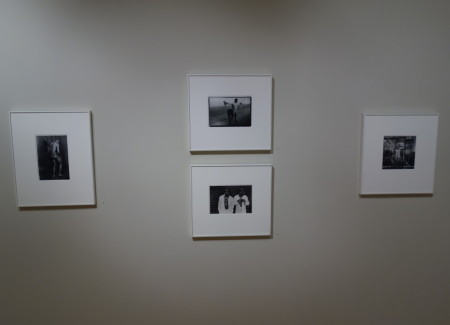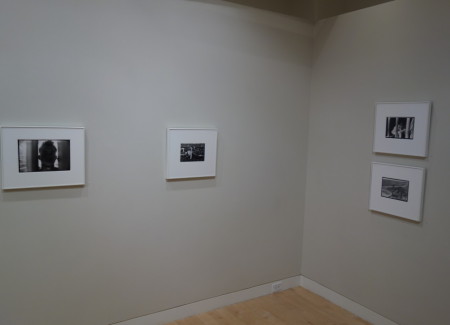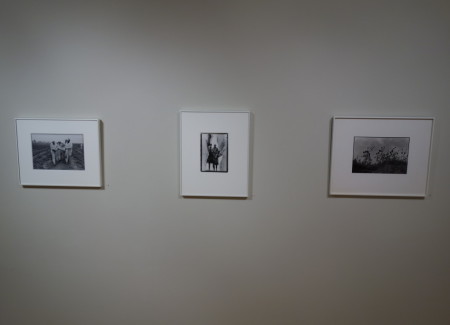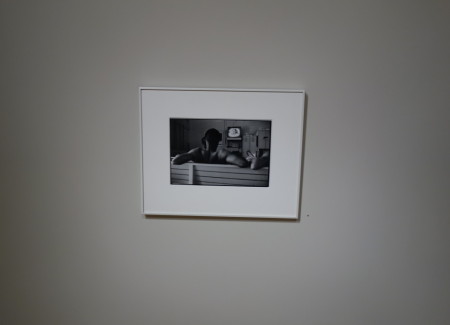JTF (just the facts): A total of 33 black and white photographs, framed in white and matted, and hung on the three walls of the main gallery space as well as on both sides of the West partition. Most of the works are vintage gelatin silver prints, made in either 1968 or 1969. Physical sizes vary but most are 8×10 or the reverse, with three prints slightly larger at 11×14, one slightly smaller at 7 1/2 square, two at 8 1/2×12 1/2 and one at 16×20. (Installation shots below.)
The exhibition coincides with the 2015 reissue by Phaidon Press (here) of the 1971 book, Conversations with the Dead: Photographs of Prison Life with the Letters and Drawings of Billy McCune #122054 by Danny Lyon. The new edition (hardcover, 11 x 8 1/8) features 88 black and white photographs, 6 color drawings and texts by Texas inmate Billy McCune, and a new afterword by Lyon. $69.95.
Comments/Context: The career of Danny Lyon, soon to be retrospected at the Whitney Museum of American Art, has been bumpier than his current Old Master status would indicate. When he began taking pictures in the 1960s, the question he must have been asked repeatedly—whether what he did should be considered photojournalism or qualified as art—may be far less pressing now than it was then. But the distinctions were drawn in the 1930s and strictly enforced by some curators and critics into the 1980s. The fence line is still patrolled with guard dogs in many gated communities of the art world.
Lyon was recognized as a star when he was only 26, with the publication in 1968 of The Bikeriders. A celebration of outlaw motorcycle culture, it has an insider-participant POV, similar to the one popularized by Hunter S. Thompson in his book on the Hell’s Angels, published the year before.
These were journalists who didn’t just talk the talk, they walked the walk. Both projects benefited from the public’s fascination with the casual mayhem and rasty sex, the lurid image of marauding gangs in black leather jackets on customized Harleys. The Wild Ones and Marlon Brando had proven the appeal of the rebel biker movie in 1953 and the 1960s saw dozens of variations on the genre, a few with Jack Nicholson. Like the characters in Easy Rider, those in the books by Thompson and Lyon raised a middle finger at Chevrolet Apple Pie America, and kids everywhere loved them for it.
But several of Lyon’s early projects were too socially aware for his documentary aesthetic to resonate with developments in art photography. His first book, The Movement, published in 1964, recorded his experiences as a Civil Rights worker with SNCC, hardly in tune with the affectless vibe of Ed Ruscha and Dennis Hopper on the West Coast or with the bemused indifference to urban political chaos exemplified by Garry Winogrand and his followers on the East Coast. Like David Goldblatt and Susan Meiselas, Lyon wasn’t impartial about what he saw as rampant injustice.
He had more formal education than most photographers of his generation, having graduated with a degree in history from the University of Chicago. The frames of his compositions were balanced, sturdy; they didn’t threaten to break apart or strain to embrace stray, incongruous, alien information. Lyon was never really a street photographer, sneaking glimpses of strangers. His prolonged engagement with his subjects looked back to the older model of Life magazine’s premier photo essayist, W. Eugene Smith, even if his unfussy prints did not.
Conversations with the Dead, published three years after The Bikeriders, is the purest expression of his humanist approach. With unfettered access to 6 prisons in Texas, he spent 14 months observing the routines of inmates and hearing their stories, in surroundings designed to crush hope. As in the books on Civil Rights workers in the South and motorcycle gangs, Lyon put himself at some risk in making the work. The threat of physical force is somewhere in the photographs, even if bleeding in from the black edges of the frames. Many of these men are behind bars for their illegal expressions of violence and the legal violence of the government keeps them there.
The exhibition deprives Lyon of one of the techniques he applies in the book, where image sequences are broken up by letters from inmates, as well as mug shots from their arrest records or prison enrollment. The book ends with writings and color drawings by the inmate Billy McCune and includes his autobiography in which he plots his years in prison against his birthdays, in a “Time Versus Age Chart.” (Lyon’s ongoing relationship with McCune here has similarities to that between Truman Capote and Perry Smith, one of the killers in In Cold Blood, published in 1966.)
The installation tries to preserve some of the original narrative progression. The first pictures on the walls along the right document the processing routine for inmates, from frisking to emptying wallets to showering to the glaring sight of a polished lock and bars.
But the absence of texts has the advantage of letting Lyon’s photographic virtuosity stand alone. If the biker pictures left one marveling at his deft one-handed ability to picture things on the road—and other riders—from the seat of a speeding motorcycle, these quieter photos highlight his sense of decorum, more important than ever in a place where freedom to walk away is not an option for his subjects. I could find no instances where I thought Lyon had intruded on a prisoner’s few feet of space or taken advantage of his floating position. Rather than look at prisoners as though they were animals in a zoo, he will portray them without bars or in the open doorway; or he’ll stand further apart and picture their cells from catwalks above. The prison farms, where gangs toil in the open air, are the most oppressive. A photograph of an African-American prisoner holding a metal jug for the boss man, who ladles water into a cup from atop his horse, could be a scene out of Cool Hand Luke, released a year earlier.
In their crisp white uniforms and patterned into lines by the discipline of an overseer, the men in these fields could be members of a religious fraternity. Lyon’s camera treats them, as they march or cut timber or pick cotton, as if they were holy, in the way that Villon, Rimbaud, Dostoevsky, Whitman, and Genet wrote about criminals, or the beatific way that Sebastião Salgado views the working class. (The Brazilian photographer was not content to absorb the discreet religious iconography Lyon displayed in this book; he had to make billboards of laborers looking crucified.)
The reissue of the book is happening amid rising concerns about the rationale of imprisoning people without any apparatus for rehabilitation. In 1971, when Conversations with the Dead was published, there were an estimated 250,000 inmates in state and federal prisons; by 2014 the number was 1,561,500.
It is clear whose side Lyon is on. No matter what their crimes, these men don’t deserve to rot away, forgotten, unseen. I would be curious to have seen more of the lives of the guards and bureaucrats; they are in some ways also brutalized by the lack of economic opportunity in these areas and by a profitable system of crime and punishment.
Dr. George Beto, then the director of the Texas Department of Corrections, is acknowledged in the book’s credits as the facilitator of this project. No warden today would venture to demonstrate such empathy for locked up criminals without dire political consequences, which makes Lyon’s feat not only remarkable but almost certainly unrepeatable.
Collector’s POV: The prints in this show are signed, dated, and titled by the photographer in pencil on verso. Some have a Magnum copyright stamp. They range in price from $12000 to $18000. Lyon’s work is consistently available in the secondary markets, with recent single image prices at auction ranging between roughly $1000 and $15000.














